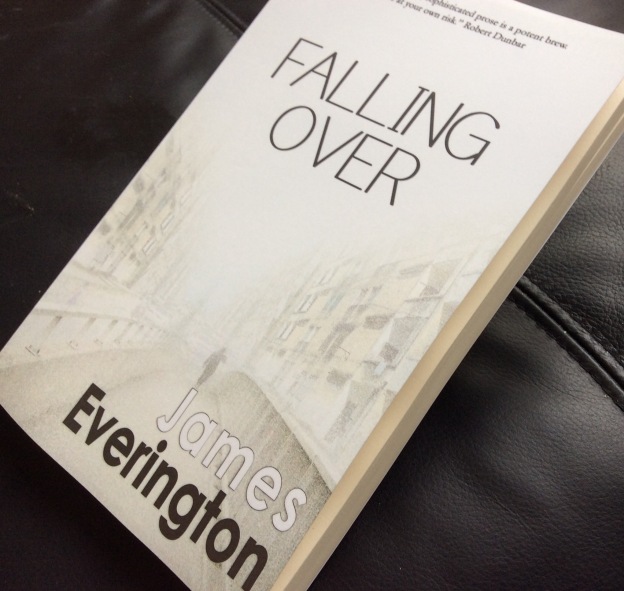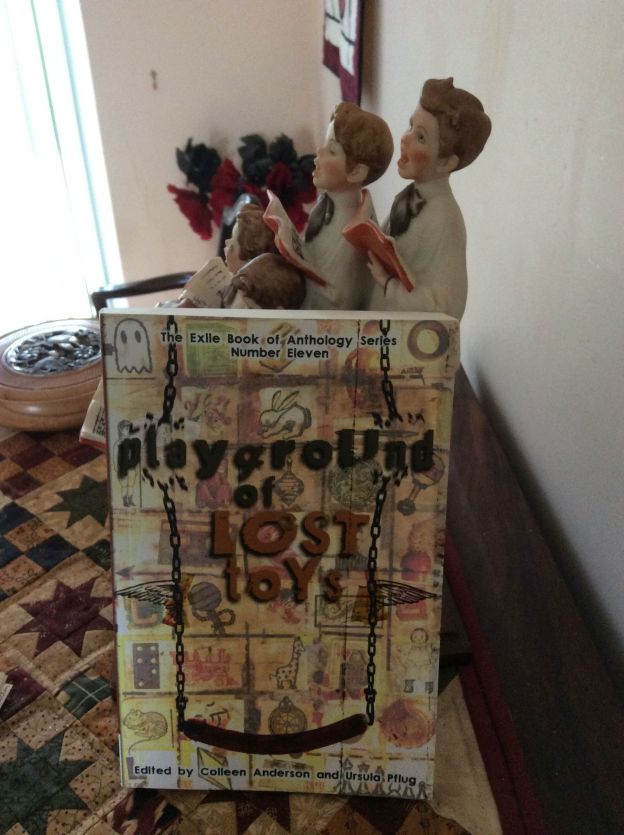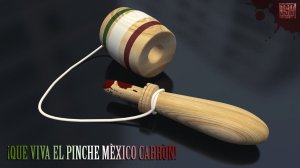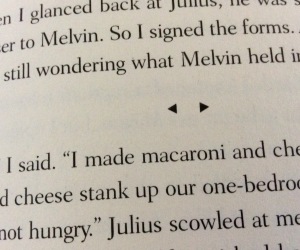Falling Over – James Everington

FALLING OVER by James Everington
infinity plus (2013)
When I real-time review this collection of stories, my comments will be found in the thought stream below or by clicking on this post’s title above.

www.nemonymous.com
Des Lewis - GESTALT REAL-TIME BOOK REVIEWS
A FEARLESS FAITH IN FICTION — THE PASSION OF THE READING MOMENT CRYSTALLISED — Empirical literary critiques from 2008 as based on purchased books.




“I couldn’t work it out, and now I have the nagging feeling that I have missed something important.”
…as if the story is talking to me – the reader and aspiring reviewer of it – with its own doublespeak?
At first I thought the plot was a constructive theme-and-variations on a mysterious school tontine (like Ishiguro’s Never Let Me Go … or Pinborough’s Death House that I happened to review here in the last week or so) in a young adult communal residential setting (although these are ostensibly a bit older as university students but still, like young adults, on the brink of future real life) but that again was my sense of doublespeak of one story masquerading as another story, and vice versa. No, my theories about this story fell over as easily as some of its characters (characters enacting, as it were, a chicklit mutual-fancying and boyfriend/girlfriend rivalries, and social hang-ups) and it eventually became its own originator. Meanwhile, I have been highly entranced by its plain-spoken, deadpan quality sown with what I have long called ‘disarming strangenesses’. Including leitmotifs of low-flying aeroplanes, of the weird aura of multiple cctv cameras, the communal TV room even when bespoke TVs are in each of the students’ rooms, the nature of the behaviour of bus passengers, availability of public payphones as well as mobiles, inscrutable head wounds and vanishing ring-lines, the erstwhile irony of such presumably modern young adults keeping handwritten diaries, and half-empty residential block hang-ups and misunderstandings. A disarming gestalt of the relative modern and the old-fashioned, each vying to mock the other with their own brands of doublespeak. The deadpan repercussions at the end are haunting, bolstered by the major theme of what I called above ‘upon the brink of future real life’ with its own resonating irony.
“– the village they were passing through was just like some Tory wet-dream of England,…”
…and they end up in a housing estate, and a flying over…
From Falling Over to falling over the edge of a flyover, in a white car, that the two pilfering rogues used as part of their stealing the ‘religious’ treasures in what appeared to be a council house amongst other council houses, to iconoclasticise the already iconoclastic, as it were – a “seeing two things at once” of the quotidian and the obscenely arcane, to compare to the seeing two things at once in the first story’s recurrent Falling Over of the old-fashioned upon the modern.
Meanwhile, this tale has a very creepy feel emerging from the dual points of view of the two pilfering rogues, a ‘motion-sickness’, as it were, a recurrence of dual dream and taking it in turns to sleep in the back of the car and to drive it from the front seat, until what I see as that slow motion fly over (like a low-flyng aircraft?) – and the insistent eponymous hitchhiker who turns up in the car with them.
The story’s recurrent dream will now be the reader’s, I genuinely fear to suggest. And the brilliantly described insides of that council house ‘church’ is not to be taken for granted, either.
[Arkansas, as a pure word (ark-can-saw), conjures up all manner of things at once – like Aickman with a saw or the soar of the vehicle (off the flyover) protecting but not protecting those inside like an invisible ark?]
A single page where I could only see the above word and the page number.
A story haunted by nothing or simply fallen off the page.
“He told himself that he wouldn’t look up, wouldn’t continue to look for something that wasn’t there.”
…indeed, vis a vis HAUNTED.
Strange that, BEFORE I started reading this book, but only JUST before (as indicated by my real-time Facebook posts advertising my then forthcoming reading of this book), I changed the banner heading of this review site from Dreamcatcher real-time reviews to Dreamcatcher slow-motion reviews.
And this story, if not this whole book, NEEDS a Dreamcatcher, in more ways than one!
I admit that NEW BOY has greatly affected me, in itself, and in its context within this book so far.
It has affected me more than many horror stories. In my business life of yore I have endured many of the tropes of this tall attenuated building, a sick building syndrome, the reactions of my staff to my managership, my own reactions to them, sitting in an office toilet cubicle and so on. On top of that, this story seems to be a doppelgänger of the first story, without being a doppelgänger at all. The same inscrutable ‘disarming strangenesses’, the same anxieties, but something even more insidious. Vertigo, slow motion-sickness, slippage, insubordination, two versions of reality panning out lazily, a sort of hanging off, a falling over, fragility, paranoia, marking territory, yet another bus scenario, a piddling moustache, doped or duped, not a sick building perhaps but a bout of team building!
A classic.
“The rain died.”
From one story I found inspiring to another, each inspiring for different reasons. This one seems to be, at least in part, an artful blend of the work of Robert Aickman (the congealed breakfasts, the over-sized fish and chip suppers, but above all the skilful ‘disarming strangenesses’) and of Frances Oliver (the naively engaging girl-boy child relationship, the ghostly rhapsodic, slightly flirtatious, dancing of others and much else). The hotel where Vince is staying on holiday with his grandma and fuzzy-headed granddad, meeting Alice with her grandmother, a tantalisingly atmospheric genius-loci, building towards creepy and essentially poignant scenes – and inspiring, too, with the modern age recoupable as an old-fashioned stylish flittery again… evoking memories of another age like the 1950s that I recall through a child’s eyes, this book’s palimpsest of time, with a smidgen of eternal hope or, at least, a final fling… I am surprised I have not heard before about this significant story from lovers of this sort of literature. The last sentence clinched it, and I dare not tell you how,
“You could tell he was odd, not eccentric but odd,…”
It is OK to be eccentric, but not to be odd, in this socially-acceptable Engish suburban area with front lawns (that I shall name Everington-cum-Bagpup), another ‘Tory wet-dream’ of a place where residents form tantamount to lynch mobs to enforce the social-acceptability of their neighbours. But gradually this strangely believable slight-absurdity of a story itself gradually became, for me, more odd than eccentric. Then I suspected its leasehold narrator was also odd rather than eccentric. Even to the point of convincing myself that the freehold author himself has more than his fair share of oddness rather than eccentricity. But, now, as the merely eccentric reader of it, I imagine mad dogs barking nearer…
“Emma walked towards her class, and noticed how slowly and solemnly the children were playing.”
This follows the same path as ‘New Boy’, returning to work after sick leave, this time a young woman teacher, with similar strangenesses and dislocations and anxieties and insubordinations of spirit, her class’s supply teacher seemingly having taught them, during her absence, about the plague of the Black Death…
But, sorry, somehow I found this version unconvincing and predictable. I liked the way, though, the children FAILED to FALL OVER after singing Ring a Ring a Rosie in the playground…
“‘Friendly Fire’ – I agree with them it’s a slimy, mealy-mouthed phrase.”
This is written from the point of view of someone nicknamed ‘Drone’, almost too good at his job as a marksman in a war in foreign fields, a marksman behind the screen controlling an unmanned drone. The particular form of shellshock he suffers from is believable, and shocking. A truly powerful work that affects us all.
[As an aside, I immediately thought of ‘The Man Dogs Hated’ alongside it. But I don’t exactly know why. Or the soaring ‘ark’ from Arkansas, falling over silently.]
“Someone else moved up alongside the man, was pressed forward right against Joel, pulling at Joel’s ill-fitting coat to keep herself from falling over.”
You won’t find this easy to believe, but it’s absolutely true – when I was about halfway through reading this story, there was a knock on my front door and I found a bearded man there holding out towards me a large framed photograph of the top of my bungalow house (where I have lived for the last 20 years), at a viewpoint seemingly not very far above the roof, also showing my car parked on the front patio and the garden behind. He said the photo would normally be £39 and I could have it for £24, but if I was a pensioner (I quite obviously am), I could have it for £20. I was a bit taken aback and, by now my wife had joined me at the door, and we both said no thank you to this strange offer, and he backed off scowling.
This has no direct connection with this story, but it did accentuate its “heavy-lidded paranoia” and its theme of unexpected and unexplained tabloid newspaper photos of the main protagonist himself. But then I thought about this book’s earlier story ‘Drones’, and I had an added frisson!
As to the story itself, it seems real if absurdist; compelling and frightening. An accreting sense of claustrophobia about being under siege from a bunch of people who seem to have seen your unexplained photo in the newspaper. The events and moods have certain artful echoes of themes running through this whole book, a Doppler effect and a dislocation (here by besieging gang), a growing angst and a disarming strangeness. And the ending – which I will not spoil here – is absolutely unexpected and original.
I hesitate to say this, for fear of praise attrition, but this story is another classic. (But I’ll mention that I noticed one of my bugbear typos: ‘stationary’ where it should have been ‘stationery’.)
“…books open, their open pages unfolding and connecting like paper streamers between us.”
A nifty short short that needs to be read and be haunted by, not described here. I was taken, however, with its ‘dream’ of the nature of gestalt DREAMCATCHERS, as hinted at by that quote.
I am pretty sure I have just discovered another favourite author to entertain me in my old age.
end